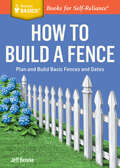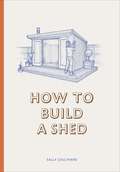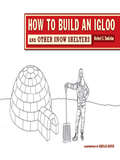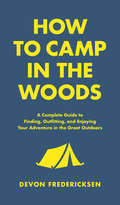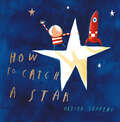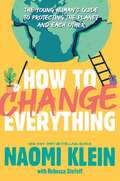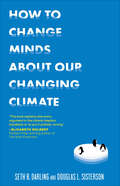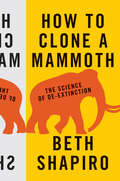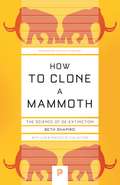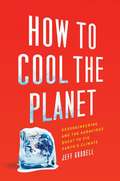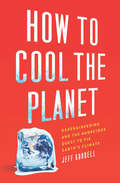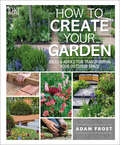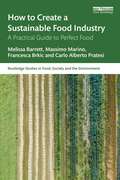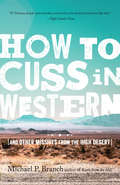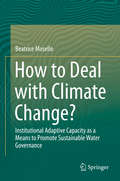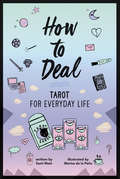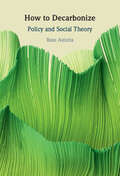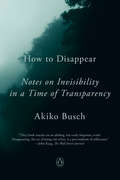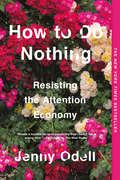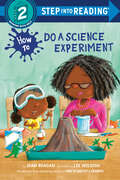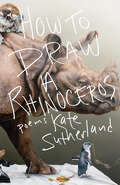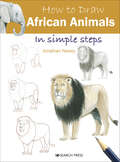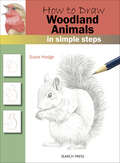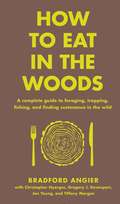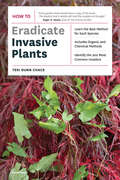- Table View
- List View
How to Build a Fence: Plan and Build Basic Fences and Gates. A Storey BASICS® Title (Storey Basics)
by Jeff BenekeWhether you want to protect your garden, provide a safe enclosure for pets, or add privacy, this Storey BASICS® guide covers you everything you need to know to build the perfect fence. Offering clear step-by-step instructions, Jeff Beneke shows you how to construct a variety of fences from wood, vinyl, and chain link. With designs that are easily adaptable to all types of yards, you’ll soon be putting up a functional and beautiful fence that works with your landscape.
How to Build a Shed
by Sally CoulthardEver dreamed of having your very own garden retreat? Off-the-shelf sheds aren’t always the answer - the cheap ones are badly made and freezing cold, and the better quality ones are really expensive. But what if you could build your own shed from scratch? How to Build a Shed is the ultimate practical guide. With its clear, easy-to-follow instructions, expert advice and specially commissioned illustrations, you'll be able to source the materials, choose the right tools and build your dream shed on a budget - even if you’ve never used a hammer.
How to Build an Igloo: And Other Snow Shelters
by Norbert E. Yankielun Amelia BauerHow are the ice blocks of igloos so perfectly formed and fitted, and able, it's been said, to withstand the weight of a polar bear? How can you determine if the fresh snow that's fallen outside your front door is as good for making a slab shelter as a snowman? What is a slab shelter, anyway? For that matter, what are drift caves, spruce traps, snow block walls, and bivy bag shelters, and how would you go about building them, whether for winter fun or protection from the weather? In this instructive, whimsical, illustrated manual, Norbert E. Yankielun, a seasoned cold-regions explorer and researcher, takes readers step-by-step through the process of constructing and inhabiting a range of useful snow structures--from the most basic to the more complex. Whether you're a veteran backcountry skier or a backyard builder, this is one book you won't want to be without.
How to Camp in the Woods: A Complete Guide to Finding, Outfitting, and Enjoying Your Adventure in the Great Outdoors (In The Woods)
by Devon FredericksenPerfect for everyone from novices to boondockers, How to Camp in the Woods compiles contemporary and classic wisdom, practical tips, and illustrated DIY advice on every aspect of equipping, packing, setting up camp, cooking, and improvising no matter where you are in the great outdoors. If you want to immerse yourself or your family in the natural world but still be warm, dry, and comfortable, How to Camp In the Woods is for you. How to Camp in the Woods will teach readers: Camping and survival basics including fire building, essential knots, site finding, wilderness first aid/CPR, map/compass reading, and camping off the grid. Essential gear, packing light, recommendations for DIY if you've left something behind, and how to keep everything relatively clean. Guides to camping comfortably in all seasons and weather, as well as tips and etiquette for camping around the world, including with pets and kids. Tips for enhancing the experience, including recipes for easy and inexpensive meals from 25 base ingredients, stargazing essentials, fireside games and songs, bird-watching, and the perfect campfire reading list.
How to Catch a Star
by Oliver JeffersFrom the illustrator of the #1 smash hit The Day the Crayons Quit comes a story about wishing, persevering, and reaching for the stars. Once there was a boy, and that boy loved stars very much. So much so that he decided to catch one of his very own. But how? Waiting for them to grow tired from being up in the sky all night doesn't work. Climbing to the top of the tallest tree? No, not tall enough. The boy has a rocket ship . . . but it is made of paper and doesn't fly well at all. Finally, just when the boy is ready to give up, he learns that sometimes things aren't where, or what, we expect them to be.Oliver Jeffers offers a simple, childlike tale of reaching for the stars, and emerging with a friend.
How to Change Everything: The Young Human's Guide to Protecting the Planet and Each Other
by Naomi KleinAn empowering, engaging young readers guide to understanding and battling climate change from the expert and bestselling author of This Changes Everything and On Fire, Naomi Klein.Warmer temperatures. Fires in the Amazon. Superstorms. These are just some of the effects of climate change that we are already experiencing. The good news is that we can all do something about it. A movement is already underway to combat not only the environmental effects of climate change but also to fight for climate justice and make a fair and livable future possible for everyone. And young people are not just part of that movement, they are leading the way. They are showing us that this moment of danger is also a moment of great opportunity—an opportunity to change everything. Full of empowering stories of young leaders all over the world, this information-packed book from award-winning journalist and one of the foremost voices for climate justice, Naomi Klein, offers young readers a comprehensive look at the state of the climate today and how we got here, while also providing the tools they need to join this fight to protect and reshape the planet they will inherit.
How to Change Minds About Our Changing Climate
by Seth B. Darling Douglas L. SistersonThe book to spark action on the defining challenge of our time In our post-truth world, there’s only one place to turn to if we want to live in reality: science. And the research on climate change is clear: It’s real, it threatens us all, and human activity is the primary cause. This essential handbook dismantles all the most pernicious misunderstandings spread by deniers and replaces them with the truth. Faced with an imperiled planet that we must urgently work to save, we don’t have time for anything else.
How to Clone a Mammoth
by Beth ShapiroCould extinct species, like mammoths and passenger pigeons, be brought back to life? The science says yes. In How to Clone a Mammoth, Beth Shapiro, evolutionary biologist and pioneer in "ancient DNA" research, walks readers through the astonishing and controversial process of de-extinction. From deciding which species should be restored, to sequencing their genomes, to anticipating how revived populations might be overseen in the wild, Shapiro vividly explores the extraordinary cutting-edge science that is being used--today--to resurrect the past. Journeying to far-flung Siberian locales in search of ice age bones and delving into her own research--as well as those of fellow experts such as Svante Pääbo, George Church, and Craig Venter--Shapiro considers de-extinction's practical benefits and ethical challenges. Would de-extinction change the way we live? Is this really cloning? What are the costs and risks? And what is the ultimate goal? Using DNA collected from remains as a genetic blueprint, scientists aim to engineer extinct traits--traits that evolved by natural selection over thousands of years--into living organisms. But rather than viewing de-extinction as a way to restore one particular species, Shapiro argues that the overarching goal should be the revitalization and stabilization of contemporary ecosystems. For example, elephants with genes modified to express mammoth traits could expand into the Arctic, re-establishing lost productivity to the tundra ecosystem. Looking at the very real and compelling science behind an idea once seen as science fiction, How to Clone a Mammoth demonstrates how de-extinction will redefine conservation's future.
How to Clone a Mammoth: The Science of De-Extinction (Princeton Science Library #108)
by Beth ShapiroAn insider's view on bringing extinct species back to lifeCould extinct species, like mammoths and passenger pigeons, be brought back to life? In How to Clone a Mammoth, Beth Shapiro, an evolutionary biologist and pioneer in ancient DNA research, addresses this intriguing question by walking readers through the astonishing and controversial process of de-extinction. From deciding which species should be restored to anticipating how revived populations might be overseen in the wild, Shapiro vividly explores the extraordinary cutting-edge science that is being used to resurrect the past. Considering de-extinction's practical benefits and ethical challenges, Shapiro argues that the overarching goal should be the revitalization and stabilization of contemporary ecosystems. Looking at the very real and compelling science behind an idea once seen as science fiction, How to Clone a Mammoth demonstrates how de-extinction will redefine conservation's future.
How to Cool the Planet: Geoengineering and the Audacious Quest to Fix Earth's Climate
by Jeff GoodellWhen Jeff Goodell first encountered the term "geoengineering," he had a vague sense that it involved outlandish schemes to counteract global warming. As a journalist, he was deeply skeptical. But he was also intrigued. The planet was in trouble. Could geoengineers help? Climate change may well be the biggest crisis humanity has ever faced. Temperatures in some regions of the world could increase by as much as fifteen degrees by the end of the century, causing rising sea levels and severe droughts. But change could also happen much more suddenly. What if we had a real climate emergency, the ecological equivalent of the subprime mortgage meltdown -- how could we cool the planet in a hurry? As Goodell shows in this bracing book, even if we could muster the political will for it, cutting greenhouse gas emissions alone may not be enough to reduce the risk of climate catastrophe. This has led some scientists to pursue extreme solutions: huge contraptions that would suck CO2 from the air, machines that would brighten clouds and deflect sunlight away from the earth, even artificial volcanoes that would spray heat-reflecting particles into the atmosphere. In How to Cool the Planet, Goodell explores the scientific, political, financial, and moral aspects of geoengineering. How are we to change the temperature of whole regions if we can't even predict next week's weather? What if a wealthy entrepreneur shoots particles into the stratosphere on his own? What about wars waged with climate control as the primary weapon? What happens to our relationship with nature when, as Goodell puts it, we all find ourselves living in a giant terrarium? And our options are dwindling. Maybe, Goodell suggests, we need to start taking geoengineering seriously. Maybe it's Plan B for the planet. And if it is, we need to know enough to get it right. Thoroughly reported and convincingly argued, How to Cool the Planet is a compelling tale of scientific hubris and technical daring. But it is also a thoughtful, even-handed look at a deeply complex and controversial issue. It's a book that will surely jump-start the next big debate about the future of life on earth.
How to Cool the Planet: Geoengineering and the Audacious Quest to Fix Earth's Climate
by Jeff Goodell&“Thoughtful, informative, and darkly entertaining. It&’s the best treatment of this important (and scary) topic you can find.&” —Elizabeth Kolbert Right now, a group of scientists is working on ways to minimize the catastrophic impact of global warming. But they&’re not designing hybrids or fuel cells or wind turbines. They&’re trying to lower the temperature of the entire planet. And they&’re doing it with huge contraptions that suck CO2 from the air, machines that brighten clouds and deflect sunlight away from the earth, even artificial volcanoes that spray heat-reflecting particles into the atmosphere. This is the radical and controversial world of geoengineering, which only five years ago was considered to be &“fringe.&” But as Jeff Goodell points out, the economic crisis, combined with global political realities, is making these ideas look sane, even inspired. Goodell himself started out as a skeptic, concerned about tinkering with the planet&’s thermostat. We can&’t even predict next week&’s weather, so how are we going to change the temperature of whole regions? What if a wealthy entrepreneur shoots particles into the stratosphere on his own? Who gets blamed if something goes terribly wrong? And perhaps most disturbing, what about wars waged with climate control as the primary weapon? There are certainly risks, but Goodell believes the alternatives could be worse. In the end, he persuades us that geoengineering may just be our last best hope—a Plan B for the environment. His compelling tale of scientific hubris and technical daring is sure to jump-start the next big debate about the future of life on earth. &“Goodell explores with infectious curiosity and thoughtful narration this strange, promising, and untested suite of climate fixes.&” —BusinessWeek &“A quick, enjoyable read through a complex, timely topic. And after you read it, you&’ll never look at the sky or the ocean—or Earth, really—in quite the same way again.&” —The Christian Science Monitor
How to Create Your Garden: Ideas and Advice for Transforming Your Outdoor Space
by Adam Frost"Creating a garden doesn't need to be complicated." This is the promise from Adam Frost, BBC Gardeners' World presenter and winner of multiple Chelsea Flower Show gold medals. Regardless of your experience or budget, with Adam's help and know-how, you can design your dream garden, whether it's a small urban garden, a classic cottage garden, a suburban front garden, a low-maintenance space or a city roof terrace. His practical, no-nonsense approach strips away complex garden design concepts and focuses on your needs and preferred garden style to help you plan and build a garden that works for you. Starting right at the beginning, Adam takes you step-by-step through the whole process, inspiring you with simple garden design ideas to tackle a full garden makeover or a simple revamp of just one part of your garden, perhaps a tired herbaceous border, a neglected vegetable patch, the patio, or a water feature. Learn how to design a garden that reflects your practical needs, lifestyle, budget, personality, soil, and climate. Build it yourself following the clear, uncomplicated, easy-to-understand instructions that show you everything from laying turf to terraces, planting trees or building a raised bed or water feature. Enjoy gardening month by month with Adam's simple checklist of what to do when to keep your garden in shape at every point throughout the year. How to Create Your Garden is about designing an outside space that is real, achievable, and right for you.
How to Create a Sustainable Food Industry: A Practical Guide to Perfect Food (Routledge Studies in Food, Society and the Environment)
by Massimo Marino Melissa Barrett Francesca Brkic Carlo Alberto PratesiThis book presents a practical guide to help businesses navigate the complex topics of sustainability in the food industry. The book takes you on a journey along the food value chain, from farm to fork, exploring key opportunities to increase positive impacts and circularity at each step of the journey. Written by a team of authors with decades of experience in the food industry and academia, it provides guidance on how to analyse sustainability across the value chain and life cycle of a food product and how to design, implement and communicate strategies to customers. Furthermore, the book shows that there are not always straightforward solutions, but rather choices and trade-offs that require an understanding of what is best suited to the product, customers and business in question. It demystifies a variety of topics, such as local sourcing, regenerative agriculture, plant-based protein and the environmental impact of meat production, and draws on a wide range of case studies from across the globe, to provide concrete, real-world examples. While a perfect food system may not exist, informed decisions can go a long way to reshape and transform the food industry as we know it. This book will be of great interest to professionals working in the food and agriculture industries, as well as students and scholars of sustainable food systems and sustainable business.
How to Cuss in Western: And Other Missives from the High Desert
by Michael P. BranchWhere nature writing meets humor--a racuous and hilarious look at life in the high desert of Nevada, from the author of Raising Wild and Rants from the Hill.Edward Abbey encouraged his readers to “be loyal to what you love, be true to the Earth, and fight your enemies with passion and laughter.” Here is Michael Branch’s response. Full of clear-eyed explorations of the natural world, witty cultural observations, and heart-warming family connections, How to Cuss in Western is a cranky and hilarious love letter of sorts to the western Great Basin Desert of Nevada.
How to Deal with Climate Change?
by Beatrice MoselloAs the evidence for human-induced climate change becomes more obvious, so too does the realisation that it will harshly impact on the natural environment as well as on socio-economic systems. Addressing the unpredictability of multiple sources of global change makes the capacity of governance systems to deal with uncertainty and surprise essential. However, how all these complex processes act in concert and under which conditions they lead to the sustainable governance of environmental resources are questions that have remained relatively unanswered. This book aims at addressing this fundamental gap, using as case examples the basins of the Po River in Northern Italy and the Syr Darya River in Kyrgyzstan. The opening chapter addresses the challenges of governing water in times of climate and other changes. Chapter Two reviews water governance through history and science. The third chapter outlines a conceptual framework for studying institutional adaptive capacity. The next two chapters offer detailed case studies of the Po and Syr Darya rivers, followed by a chapter-length analysis and comparison of adaptive water resources management in the two regions. The discussion includes a description of resistant, reactive and proactive institutions and puts forward ideas on how water governance regimes can transition from resistant to proactive. The final chapter takes a high-level view of lessons learned and how to transform these into policy recommendations and offers a perspective on embracing uncertainty and meeting future challenges.
How to Deal: Tarot for Everyday Life
by Sami Main“How to Deal is an invaluable resource for those interested in reading tarot cards. It is easy to understand, insightful and beautifully illustrated; it will be a book I continue to go back to for reference for years to come.” — Loryn Brantz, bestselling author of Feminist Baby“This is a fun and introspective approach to tarot.” — Publishers Weekly“Readers will learn that tarot is…used to understand one’s personality and place in the spiritual universe. Those curious about themselves and looking for a new road to self-discovery will enjoy.” — Voice of Youth Advocates (VOYA)
How to Decarbonize: Policy and Social Theory
by Ross AstoriaHow to Decarbonize explores opportunities for decarbonization introduced by recent federal legislation, which has prompted state-level climate planning. It is designed for students and professionals whose work brings them into contact with these opportunities, even if climate is not their primary profession, including city managers, bankers, and home builders who are interested in participating in planning for decarbonization. Chapters aim to support the successful uptake of these policies by providing high-level views of these new decarbonization policies using social theory. The book is divided into four sections, each introducing a social theory about the organization of societies and how they change, and then providing examples to demonstrate the intricacies of implementation.
How to Disappear: Notes on Invisibility in a Time of Transparency
by Akiko BuschVivid, surprising, and utterly timely, Akiko Busch's HOW TO DISAPPEAR explores the idea of invisibility in nature, art, and science, in search of a more joyful and peaceful way of living in today's increasingly surveilled and publicity-obsessed worldIn our increasingly networked and image-saturated lives, the notion of disappearing has never been both more enchanting and yet fanciful. Today, we are relentlessly encouraged, even conditioned, to reveal, share, and self-promote. The pressure to be public comes not just from our peers, but vast and pervasive technology companies, which want to profit from patterns in our behavior. A lifelong student and observer of the natural world, Busch sets out to explore her own uneasiness with this arrangement, and what she senses is a widespread desire for a less scrutinized way of life--for invisibility. Writing in rich painterly detail about her own life, her family, and some of the world's most exotic and remote places--from the Cayman Islands to Iceland--she savors the pleasures of being unseen. Discovering and dramatizing a wonderful range of ways of disappearing, from virtual reality goggles that trick the wearer into believing her body has disappeared and to the way Virginia Woolf's fictional Mrs. Dalloway feels a flickering of personhood as an older woman, Busch deliberates on subjects new and old with equal sensitivity and incisiveness.A unique and exhilarating accomplishment, HOW TO DISAPPEAR is a shimmering collage of poetry, cinema, memoir, myth, and much more, which overturns the dangerous modern assumption that somehow fame and visibility equate to success and happiness. Busch presents a field guide to invisibility, reacquainting us with the merits of the inconspicuousness, and finds genuine alternatives to the typical life of perpetual exposure. Accessing timeless truths in order to speak to our most urgent contemporary problems, she inspires us to develop a deeper appreciation for personal privacy in a vast and invasive world.
How to Do Nothing: Resisting the Attention Economy
by Jenny OdellA galvanizing critique of the forces vying for our attention—and our personal information—that redefines what we think of as productivity, reconnects us with the environment, and reveals all that we’ve been too distracted to see about ourselves and our world <P><P>Nothing is harder to do these days than nothing. But in a world where our value is determined by our 24/7 data productivity . . . doing nothing may be our most important form of resistance. So argues artist and critic Jenny Odell in this field guide to doing nothing (at least as capitalism defines it). <P><P>Odell sees our attention as the most precious—and overdrawn—resource we have. Once we can start paying a new kind of attention, she writes, we can undertake bolder forms of political action, reimagine humankind’s role in the environment, and arrive at more meaningful understandings of happiness and progress. <P><P>Far from the simple anti-technology screed, or the back-to-nature meditation we read so often, How to do Nothing is an action plan for thinking outside of capitalist narratives of efficiency and techno-determinism. Provocative, timely, and utterly persuasive, this book is a four-course meal in the age of Soylent. <P><P><b>A New York Times Bestseller</b>
How to Do a Science Experiment (Step into Reading)
by Jean ReaganScience is a blast, when you work together with Grandma! Follow the volcano fun in this silly Step 2 early reader story from the New York Times bestselling creators of How to Babysit a Grandpa.Once you've learned how to make a volacano at home, it's time to teach Grandma what to do! But what happens when you don't remember the right ingredients? Work together with Grandma to create the best at-home volacno ever, with a few tips and tricks from the experts -- kids! This Step into Reading story features a sweet Grandma and grandchild relationship and all the silly, sticky moments that come with creating an at-home experiment. Perfect for children who are ready to read on their own! Step 2 readers use basic vocabulary and short sentences to tell simple stories. They are perfect for children who recognize familiar words and can sound out new words with help.
How to Draw a Rhinoceros
by Kate SutherlandHow to Draw a Rhinoceros, the first book of poems by Canadian writer, scholar, and lawyer Kate Sutherland, mines centuries of rhinoceros representations in art and literature to document the history of European and North American encounters with the animal--from the elephant-rhinoceros battles staged by monarchs in the Middle Ages; the rhinomania that took hold in response to the European travels of Clara the 'Dutch' Rhinoceros in the mid-1700s; the menageries and circuses of the Victorian era; the exploits of celebrated twentieth-century hunters like Teddy Roosevelt and Ernest Hemingway; and the trade in rhinoceros horn artefacts that thrives online today. Along the way, it explores themes of colonialism, animal welfare, and conservation, combining Robert Kroetschian documentary poetics with the meticulous research and environmental passion of Elizabeth Kolbert, to successfully examine the centuries-long path of the rhinoceros that's brought it to the brink of global extinction.Readers of contemporary poetry, as well as those interested in natural history, animal welfare, and conservation, and people who have followed Sutherland's scholarly and literary careers, will relish the rich detail and odd tales of historical rhinoceroses and the people who have kept, shown, and traded in them, as depicted using a range of poetic techniques that only a critical eye like Sutherland's could deliver.
How to Draw: African Animals
by Jonathan NeweyCapture the splendour of the African savannah by drawing this collection of stunning animals and birds. Watch them come to life in six easy steps. Award-winning artist Jonathan Newey teaches you to transform simple shapes into the iconic Big Five (lion, leopard, rhinoceros, elephant and buffalo), as well as towering giraffes, distinctive zebras and striking flamingos. There are 26 different animals to create, in a variety of poses and styles. Each project starts with a few basic outlines and progresses into a finished tonal drawing, and a final coloured version shows you how to develop your drawing even further. Perfect for beginners, as well as budding artists, you’ll be amazed how easily you too can draw African animals with this inspiring guide.
How to Draw: Woodland Animals
by Susie HodgeLearn how to draw all kinds of woodland animals using this fun and easy step-by-step method. Starting with simple shapes, Susie Hodge shows you how easy it is to develop circles, rectangles, squares and ovals into an exciting selection of animals and birds including rabbits, badgers, woodpeckers, wolves, squirrels and chipmunks. If you have never drawn before this is definitely the book for you, and there is a lot here to inspire more experienced artists too.
How to Eat in the Woods: A Complete Guide to Foraging, Trapping, Fishing, and Finding Sustenance in the Wild (In the Woods)
by Jon Young Bradford AngierA comprehensive, practical, and reliable guide to finding food in the woods and living off the land, by respected wilderness survivalists. With text by wilderness survivalists, the information in How to Eat in the Woods is tried, trusted, and true. One of the most complete books written on the subject, this portable guide includes essential information on how to track, trap, kill, and prepare various types of animals; select bait, land fish, and clean and cook the catch; recognize edible plants, fruits, berries, and nuts; locate bird eggs; catch edible insects; and find potable water. Also included is information on building a fire and preparing food without utensils.
How to Eradicate Invasive Plants
by Teri Dunn Chace“Every garden shed should have a copy of this book. The wisdom that it wields will hold the invaders at the gate.” —Roger B. Swain, The Victory GardenHow to Eradicate Invasive Plants offers a clear, practical solution to the increasingly common problem of invasive plants. Clearly written and easy-to-use, Teri Dunn Chance shows you how to recognize more than 200 common invasive plants and offers organic and responsible chemical eradication options for each species. With this reference on their shelves, gardeners, landscapers, and managers of public and private land across the country can confidently tackle the invasive plants to make room for a sustainable plant community!
